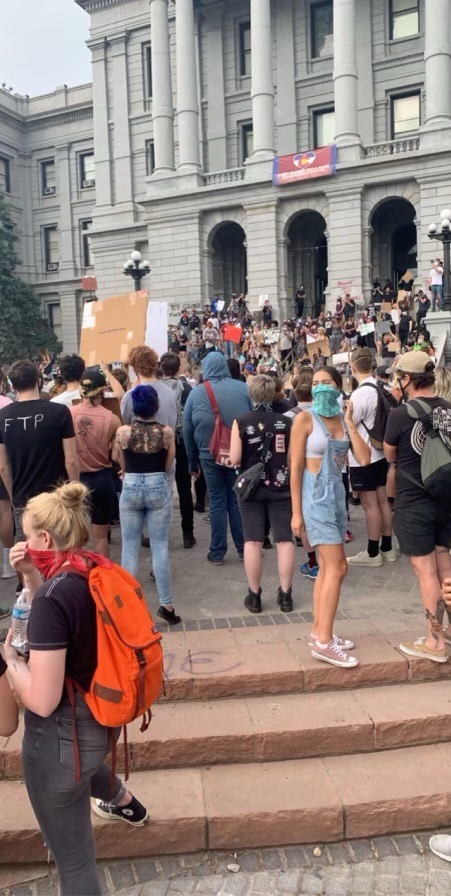This story is one of three from a series about protests around the world.
As you know, the Black Lives Matter protests made many headlines this summer as people gathered in the streets to march against racism and police brutality. This includes many young students who were seen at the forefront of these demonstrations showing their support for the movement. So how are young students affecting the Black Lives Matter Movement? How is it affecting them? Two juniors from LHS, KC Lynch and Ella Jahns both intend on answering those questions and spreading awareness about their experience protesting in June.

“We went on a Sunday at 1:00pm, a little bit after the protest had started. In the beginning it was a lot of marching around Capitol Hill. It was pretty peaceful until we reached a bus station downtown where there was a standoff between police and protesters,” Lynch said.
Jahns, who was standing next to her at the time of the standoff, recounted the shocking moment when police and protesters began to clash.
“In between us there was this area of ‘no man’s land’ and everyone was yelling at each other because we weren’t backing down and neither were the police,” Jahns said.
Emotions ran high for both girls during this moment. It was as if the ugly head of U.S. history had reared itself in the scene playing out in front of them.

“We just stood our ground, because there wasn’t anywhere that all of us could go. We started to kneel and say the ‘Hands up don’t shoot’ chant, and I guess during this someone threw an empty plastic water bottle at the police. I didn’t see it happen but I heard that someone did it. Shortly after they started firing tear gas and everyone started running, after this we went home,” Lynch said.
Although there was an altercation with the police both Lynch and Jahns said they did not see anyone get harmed.
“We didn’t see anyone get hurt, but we did see the aftermath. That experience was crazy for me because that was the moment I realized this conflict was bigger than I could’ve imagined. You always hear about the violent protests and I realized who was really being violent in that situation,” Lynch said.
According to both girls only one plastic water bottle was thrown at the police and there was no physical contact between police and protesters. The authorities still shot pepper balls and tear gas in order to force demonstrators to obey their request to move to the park.
“They were wearing full riot gear, which was why I was shocked by their reaction to the empty plastic bottle. Like you really feel the need to shoot pepper balls and tear gas over that?” Jahns said.
After the standoff with the police officers, Lynch and Jahns decided to leave. This would be the first of multiple protests both girls would attend. In contrast to the first protest they went to, Lynch and Jahns agreed that the demonstrations they took part in later were extremely peaceful. They stated that there was an unusual silence in the streets and hardly any police present. Both agreed that what the media was portrayed on the news was very different from their experience in real-time.
“I think the media likes to profit on the fact that there’s rioting and don’t show the actual peaceful parts because it’s not sensational,” Jahns said.
“I saw the news covering the first protest reporting the violence as if it were the protester’s fault. And I didn’t see that at all. They were saying that the police were being provoked. I don’t know if you should count one empty plastic water bottle being thrown at the police as provocative,” Lynch said.
Both girls agreed that the tension created in that first protest was greatly influenced by the presence of the media. They stated that the documentation of the standoff almost called for action.
“I think the media being there almost provokes violence because it makes police and protesters feel like they have to do something, and it made everyone feel on edge, like something needed to happen,” Lynch said.
As the conversation progressed Lynch and Jahns discussed what they learned from their experiences and how they’ve become educators in their community. Both of them agreed that this movement was not up for interpretation or something to be ignored, concluding that silence about this movement is violence and that the willful ignorance of the public is the unspoken language of the oppressor.
Both Lynch and Jahns agreed that the racism and police brutality situation in the U.S. would not drastically change after 2020. This year is not the “be all end all” of the movement, 2020 is yet another wake-up call that’s been put on hold since the 1600s. So it’s fair to say that things will change but not this year or in a short amount of time.
“The situation is not gonna change because people don’t want it to. The people who are victims of police brutality have been distorted. For example, in Breonna Taylor’s case they used her boyfriend shooting at the police to rationalize her death.” Lynch said.
“Why is it that when white people are convicted we worry about their future but when black people are killed we worry about their past?” Lynch said.
A fair question for the American public.
